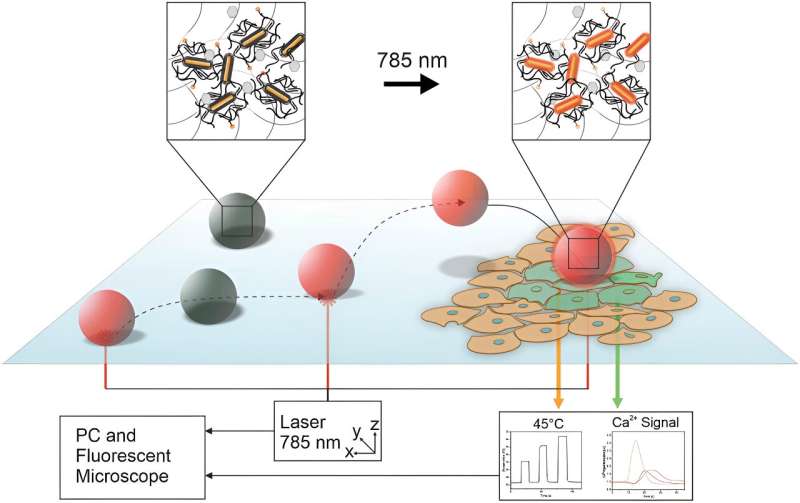A group of researchers at the Technical University of Munich (TUM) has developed the world’s first microrobot (“microbot”) capable of navigating within groups of cells and stimulating individual cells. Berna Özkale Edelmann, a professor of Nano- and Microrobotics, sees potential for new treatments of human diseases. The research is published in the journal Advanced Healthcare Materials.
The microbots are round, half as thick as a human hair, contain gold nanorods and fluorescent dye, and are surrounded by a biomaterial obtained from algae. They can be driven by laser light to move between cells. These tiny robots were invented by Prof. Berna Özkale Edelmann. To be exact, the bioengineer and director of the Microrobotic Bioengineering Lab has worked with her team of researchers to develop a technological platform for the large-scale production of these vehicles. They are currently being used in vitro, outside the human body.
Minirobots: A taxi ride to the cell
The TACSI microbots differ from classical humanoid robots or robotic arms as seen in factories. The entire system requires a microscope to enlarge the small-scale worlds, a computer and a laser to drive the 30-micrometer (µm), human-controlled microbots. The robots can be heated, and they also continually indicate their temperature. This is important because, along with the ability to find their way to individual cells, they are also designed to heat the locations of individual cells or cell groups.
TACSI stands for Thermally Activated Cell-Signal Imaging. In simple terms, it is an image-based system that is capable of heating cells in order to activate them. TACSI is a “taxi” in every sense of the word—in the future, the tiny robot will “drive” directly to the location where researchers wish to study cellular processes. “In a worldwide first, we have developed a system that not only enables microbots to navigate through groups of cells. It can even stimulate individual cells through temperature changes,” says Prof. Özkale Edelmann.
How are microbots made?
The production of microbots is based on “microfluidic chips” that model the manufacturing process. Biomaterial is injected through a channel on the left-hand side of the chip. An oil with specific components is then added from above and below through 15–60 µm channels. The finished robots emerge on the right. In the case of the TACSI microbot, the following components are added:
- A fluorescent dye: in this case the orange rhodamine B dye is used that loses color intensity with increasing temperature. This makes the microbot an effective thermometer for the observer.
- Gold nanorods: the 25–90 nanometer (nm) precious metal rods have the property of heating rapidly (and cooling down again) when bombarded with laser light. It takes only a few microseconds to raise the temperature of the robot by 5°C. The nanorods can be heated to 60°C. Through the automatic temperature balancing process of the nanorods (known as convection), the robots are set in motion at a maximum speed of 65 µm per second.
“This makes it possible to make up to 10,000 microbots in a single production run,” explains Philipp Harder, a member of the research team.
Cells respond to temperature changes
Small temperature changes are sometimes enough to influence cell processes. “When the skin is injured, for example through a cut, the body temperature rises slightly, causing the immune system to be activated,” explains Prof. Özkale Edelmann.
She wants to learn more about whether this “thermal stimulation” can be used to heal wounds. There is also a lack of research on whether cancer cells become more aggressive when stimulated. Current studies show that cancer cells die off at high temperatures (60°C). This effect can also be used to treat heart arrhythmia and depression.
Calcium import: Ion channels in cells opened
Researchers on Prof. Özkale Edelmann’s team used kidney cells to demonstrate that cellular ion channels can be influenced. To do this, they steered the TACSI microbots to the cells. “We used the infrared laser to raise the temperature. To measure the increase, we measured the intensity of the rhodamine B dye color,” explains Philipp Harder. The team observed that the ion channels of the cells opened at certain temperatures, for example to allow calcium to enter the cell.
“Using this concrete example, we showed that heat causes changes in the cell, even with slight temperature increases,” says Prof. Özkale Edelmann. She hopes that further research will point the way to new treatments—for example by making it possible to channel drugs into individual cells.


